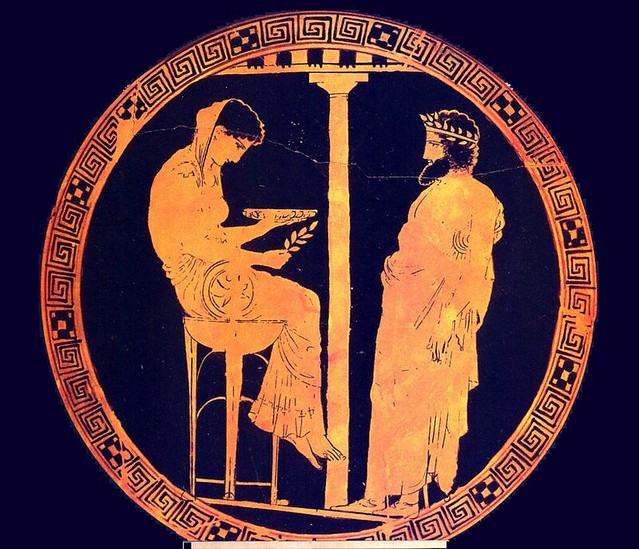
"The deepest core of life is poetry and symbol." - Dane Rudhyar
Like Symbol Reader on Facebook
-
-
Recent Posts
Categories
Archives
Meta










Tag Archives: Christianity
The Sibyls
“But she stood … black like an ancient citadel … as the words, which unrestrained now multiplied in her against her will, screamed and flew around her in incessant circles, while those that had returned home set darkly beneath her … Continue reading
Posted in The Sibyls
Tagged Aeneas, Aeneid, Apollo, archetypes, Black Madonna, black meteor, cave, Christianity, Cumae, Cybele, Delphi, Gaia, goddess, Great Mother, Greece, Hermes, Libyan Sibyl, Loreto, mythology, oracle, Pausanias, Pessinus, poetry, prophecy, Pythia, Sibylline Books, Sibyls, stone, symbolism, symbols, Tarquinius
7 Comments
Matar Kubileya (Cybele)
I. “Numinous sites of the preorganic life, which were experienced in participation mystique with the Great Mother, are mountain, cave, stone, pillar, and rock – including the childbearing rock – as throne, seat, dwelling place, and incarnation of the Great … Continue reading
Posted in Cybele
Tagged Anatolia, archetypes, beasts, Christianity, Cybele, Galli, goddess, Hermes, Kubileya, Kybele, Lion, lions, Magna Mater, meteor, mother goddess, mountains, naiskoi, Pessinus, Phrygia, Rome, symbolism, symbols, Virgin Mary
3 Comments
Black Madonna: An Icon of Mystery
“There is a grave aura about many of the Black Virgins, an expression of utter solitude so intense that the child on her knees or in the embrace of her left arm seems strangely appended. She sits, solitary, weighted, at … Continue reading
Posted in Black Madonna
Tagged alchemy, archetypes, black, Black Madonna, blackness, C.G. Jung, chaosorder, Christianity, creation, Dark Feminine, Dark Virgin, depth psychology, earth, enlightenment, feminine, God, goddess, matter, mysticism, nature, nigredo, religion, Soul, symbolism, symbols, transformation, transmutation, Trinity
10 Comments
Reading The Red Book (37) – Seven Sermons to the Dead
Seven Sermons to the Dead (Septem Sermones ad Mortuos) is a collection of seven Gnostic texts written and privately published by C. G. Jung in 1916, under the title Seven Sermons to the Dead, written by Basilides of Alexandria, the City … Continue reading
Posted in The Red Book by C.G. Jung
Tagged Alexandria, archetypes, Atman, Basilides, C.G. Jung, Christianity, fullness, gnosis, Gnosticism, individuation, Jungian psychology, Liber Novus, nothingness, opposites, Philemon, pleroma, psyche, religion, Septem Sermones, Soul, symbolism, symbols, The Red Book
7 Comments
Reading The Red Book (33)
“One can certainly gain outer freedom through powerful actions, but one creates inner freedom only through the symbol.” C.G. Jung, The Red Book, Liber Secundus, chapter XX Chapter XX of Liber Secundus, the middle part of Jung’s Red Book, has … Continue reading
Posted in The Red Book by C.G. Jung
Tagged analytical psychology, archetype, C.G. Jung, Christ, Christianity, cross, Hermes, Jesus, Liber Novus, Liber Secundus, magic, Moses, Nehushtan, prisca theologia, psyche, serpens mercurialis, serpent, snake, Soul, symbolism, symbols, the way of the cross, transcendent function, unconscious, unity of opposites
3 Comments
Reading The Red Book (28)
“I see behind you, behind the mirror of your eyes, the crush of dangerous shadows, the dead, who look greedily through the empty sockets of your eyes, who moan and hope to gather up through you all the loose ends … Continue reading
Posted in The Red Book by C.G. Jung
Tagged Anabaptism, animal, archetypes, Bergson, C.G. Jung, Chaos, Christianity, Cook, Ezechiel, Ezekiel, four, instinct, intuition, intuitive method, Liber Novus, madness, mandala, psyche, psychology, Soul, symbolism, symbols, tetramorph, the dead, The Red Book, the Self, the unconscious, unconscious
3 Comments
Reading The Red Book (27)
The title of Chapter XIV of Liber Secundus, the second part of The Red Book, is Divine Folly. Jung* finds himself in a library, where he engages in a dialogue with a librarian. He summarizes the atmosphere as “troubling-scholarly ambitions-scholarly … Continue reading
Posted in The Red Book by C.G. Jung, Uncategorized
Tagged analytical psychology, archetypes, beatitudes, blessings, C.G. Jung, Christ, Christianity, depth psychology, Eugen Drewermann, imitation, individuation, Jesus, Liber Novus, librarian, life, Nietzsche, psyche, Soul, symbolism, symbols, The Imitation of Christ, The Red Book, the unconscious
4 Comments
Reading The Red Book (18)
“The stars whisper your deepest mysteries to you, and the soft valleys of the earth rescue you in a motherly womb.” C. G. Jung, Liber Novus We have reached chapter V of Liber Secundus, which is the second part of … Continue reading
Posted in The Red Book by C.G. Jung, Uncategorized
Tagged alchemy, ancient Egypt, anima mundi, archetypes, C.G. Jung, Christianity, darkness, depth psychology, Egyptian mythology, Helios, khepri, Liber Novus, light, paganism, Philosophical Tree, scarab, shadow, sun, symbolism, symbols, The Red Book, tree, world soul
5 Comments
A Reedeming Darkness of The Black Madonna
“Underneath all our conditioning, hidden in the crypt of our being, near the waters of life, the Black Virgin is enthroned with her Child, the dark latency of our own essential nature, that which we were always meant to be.” … Continue reading
Posted in The Black Madonna, The Dark Goddess, Uncategorized
Tagged alchemy, archetypes, Artemis, Black Madonna, body, Buddha, Buddhism, C.G. Jung, Chartres, Christianity, Cybele, Dark goddess, darkness, death, Einsiedeln, enlightenment, Ephesus, fertility, Gnosticism, goddess, isis, Lyons, Mary Magdalene, Montserrat, nothingness, paganism, Paris, Shulamite, shunyata, Songs of Songs, Sophia, Soul, spirituality, symbolism, symbols, tantra, Tara, Underworld, wisdom, womb
13 Comments
Notre-Dame de Paris
https://www.youtube.com/watch?v=aUrULTifMPc In “Civilization,” a classic TV series of 1969, standing in front of Notre-Dame, Kenneth Clark asked: “What is civilization? I don’t know. I can’t define it in abstract terms — yet. But I think I can recognize it when … Continue reading
Posted in Notre-Dame, Uncategorized
Tagged alchemy, archetypes, architecture, C.G. Jung, cathedrals, chimeras, Christianity, civilization, Eugène Viollet-le-Duc, fire, Fulcanelli, gargoyles, goddess, Gothic, isis, light, Mary, masons, Notre-Dame, Our Lady, Ouspensky, Paris, spirituality, stained glass, Stryge, symbolism, symbols, the Middle Ages, Vasari, Virgin
27 Comments

